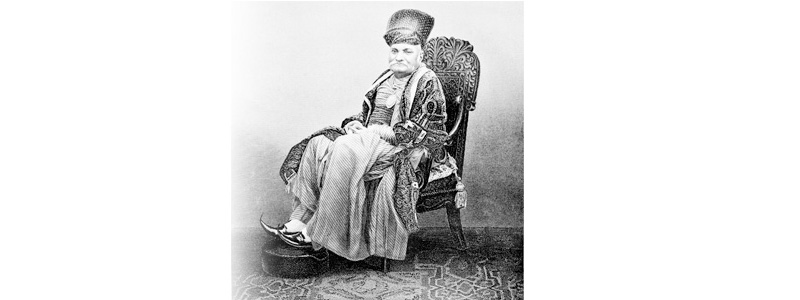Sir Jamsetjee Jejeebhoy, the first Knight of Bombay, the first Indian Baronet, the pride of Parsis, and the first to delve deep into his pockets to bring succor to those in distress, was born 233 years ago on 15th July 1783 in Bombay, to Jejeebhoy and Jeevibai at Yatha Ahuvario Mohlla, somewhere near where Crawford Market stands today. Jejeebhoy and Jeevibai had three sons and two daughters. The youngest was Jamsetjee. They were as poor as the church-mouse but inspite of being poor, Jejeebhoy’s was a highly respected family. When Jamsetjee was five years old, Jejeebhoy decided to return to his native Navsari where they lived in a quaint little house which is today a museum that has retained the old time essence of a hard-working weaver.
Jejeebhoy was not able to give any formal education to his children, not even one in what was called as ‘Mehtaji’s’ school. One can imagine young Jamsetjee living a carefree and playful life somewhat akin to what Mark Twain would portray. Yet this did not prevent the parents from giving a solid moral grounding to their children, especially to young Jamsetjee. Jejeebhoy and Jeevibai both thought very highly of their youngest lad.
Jamsetjee lost his Mother on April 9, 1799. His father followed his beloved wife September 16 of the same year. Their son rose to dizzying heights of greatness that no other Zoroastrian had risen to, since the landing at Sanjan. Jamsetjee decided to make a living in Bombay. As he was about to set out on the long and hazardous journey, a kind lady neighbour gave him a bundle of eatables to tide over his hunger on the long adventurous trip fraught with danger – up hill, down dale, across streams and rivers, and finally to Bombay.
Years later, young Jamsetjee grew rich, a Merchant Prince. He earned a spotless reputation as a man of honesty and integrity. He earned a lot, he gave a lot. Philanthropy was but an extension of his being a Merchant Prince. His philanthropy transcended all geographical boundaries and communal prejudices. He left behind him a long trail of collateral benefits from every action he took. His lack of education did not allow him to remain illiterate. In course of his work and his travels, he learnt to read and write, acquired skill in bookkeeping, and he picked up good English.
In Gujarat and in it surrounding territories, Jamsetjee learnt of the abject poverty amongst the Parsis. He realized the only permanent solution to this was education. In 1842, the year he was conferred his Knighthood, he created a fund and extended himself in every direction to promote learning. He sent donations to the Naval School at Devanport, England; he created an endowment for the Grant Medical College, donated to its Students’ Literary and Scientific Society; had books translated in Gujarati; he supported the teaching of Zend, built schools, established the country’s premier School of Art. When the Bombay University was established on February 21, 1857 he was appointed one of the first five Fellows. This is the man who did not have the benefit of any school education!
He wrote in his letter to the Governor of Bombay, Sir George Arthur, “That the interest from the fund shall be applied towards relieving the indigent of our people, and the education of their children, and I now propose to invest the sum of Rs.3,00,000/- and place it at the disposal of Trustees, who with interest shall carry out the object I have mentioned.” The total amount actually offered by Sir Jamsetjee came to a then colossal sum ofRs. 4,44,000/-. After long but fruitful correspondence, The Trust Deed was finally signed on January 9, 1849. Thus was born Sir Jamsetjee Jejeebhoy Parsi Benevolent Institution with eleven trustees and Sir Jamsetjee as the Chairman. Somewhere in Bora Bazar, with 200 students The Central English School began on October 17, 1849. Little later it got its present nomenclature, Sir Jamsetjee Jejeebhoy Fort Boys’ High School. This was the beginning of the learning renaissance amongst the Parsis.
Shortly after the Boys’ School opened, Dadabhai Naoraji appealed to the Trustees for financial help to start a Girls’ school. Sir Jamsetjee immediately took to the idea even before Dadabhai could explain the advantages of educating the girl child. He took upon himself the task of starting a girls’ school. Next year, on August 17, 1850 two girls’ schools were opened, one at Fort and the other at Alhaibaug. This was the time when a huge majority of Parsis were, opposed vehemently to sending girls to school. Sir Jamsetjee had to face bitter criticism from the orthodox. Today these schools in Maharashtra and Gujarat stand as monuments of a great mind and a noble heart.
Sir Jamsetjee Jejeebhoy, 1st Baronet passed away April 15, 1859, mourned by his family, community, country and the British Empire. In 1859 there were nineteen schools run by Sir JJPBI.
Due to the paucity of space the school was shifted a few times and the foundation stone was finally laid in presence of the Governor of Bombay, Sir William Fitzgerald and Sir Jamsetjee Jejeebhoy 2nd Baronet, on February 21, 1871.
- Adarji Angrez! - 16 March2024
- V-Day – The D-Day! - 10 February2024
- Eighteen Going On Eighty! - 13 January2024
